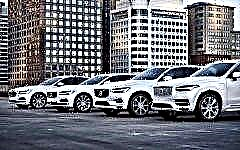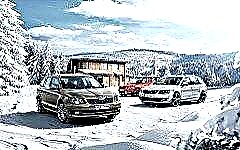

The content of the article:
- Polski Fiat 126p
- Skoda 110 R
- Melkus RS 1000
- Wartburg 353
- GAZ-24
- Tatra T603
- EMW 340
- Lada 2107
- Trabant 601
- Lada niva
The machines of the countries of the socialist camp now seem at least primitive and strange, but also funny and even frightening. Some were too Spartan, some were literally outstanding, but each of them was famous and worthy of attention in its own way.
1. Polski Fiat 126p

This baby was for the Poles the same symbol of her era, as for the Soviet citizens - “Zaporozhets”. The car was affordable and unpretentious, so both newlyweds and elderly couples could afford to purchase it. Moreover, the compact size of the car did not embarrass its owners so much that they even went on a journey on these "ladybugs".
Born on Italian soil, Fiat almost simultaneously began production in Poland, where it reached the peak of its popularity. An agreement between the two automakers was reached in advance, the corresponding license was obtained, therefore, two production facilities were prepared in advance for the production of the model: in the city of Bielsko-Biala, the engines were manufactured, and in Tychy, the cars themselves.
The model replaces the iconic Fiat 500, and its now clumsy and rude-looking design was ultra-trendy and eye-catching in the 70s. Like the 500 model, the gasoline 2-cylinder engine, producing 23-26 horsepower, was located at the rear of the car.
There was no question of comfort in such a car: the interior could accommodate 4 passengers, and only children were tried to sit behind, and the trunk provided a ridiculous volume of 100 liters. In order to allocate more space to the passenger compartment, the designers went to different tricks: the wheels were installed 12 inches in size, the two-cylinder air vent was spared from the volumetric cooling system, and all the units and the engine were trying to assemble as tightly as possible.
In total, Italy produced 1.5 million tiny cars and another 3.5 million from Poland. And the very idea of the Fiat design went far beyond the borders of these countries. For example, Austria produced 2 thousand copies of similar models under the Steyr brand, Denmark affectionately named its creations “mouse” - Topolino, and in England one could find right-hand drive modifications of De Ville or Saloon.
2. Skoda 110 R

Today's car enthusiasts are used to associating the Skoda brand with fairly simple, but reliable and safe cars. But once the company produced excellent sports cars, demonstrating dynamics and speed comparable to Ferrari and Lamborghini.
The Skoda 110 R is now a coveted exhibit for collectors around the world. This rear-engined coupe had a 62-horsepower 1.1-liter engine, which accelerated the car to 145 km / h. The idea of this development came from the heads of the company in the 60s, when almost everyone owned their own car and yearned for something new. It was a time when all Europeans, with bated breath, followed the growing popularity of auto racing and dreamed of rushing along the highway at a deafening speed at least once.
By modern standards, the Skoda 110 R was an extremely low-powered car, but at that time it knew how to show itself on ring tracks and rallies. The external appearance was also relevant - a rather wide, as if chopped off in front, a fastback roof, a general squat silhouette, large headlights, unframed glass. All this gave the model style, sportiness and originality.
The car was produced for more than 10 years, the final copy rolled off the assembly line on the last day of 1980, rounding up the circulation to 57 thousand units. But the model was not consigned to oblivion, on its basis other sports cars of this Czech brand were created.
3. Melkus RS 1000

Another sports car of the era of socialism, although it was released in more than a modest circulation compared to its Czech counterpart - 104 cars. It was supposed to be an exclusively racing model, but due to difficult times and transportation problems, the car had to be modified so that it could independently get to the competition site. It had a fiberglass body mixed with polyester resin, engine power ranged from 70 to 102 horsepower, and speeds up to 160 km / h could be achieved due to the car's low weight of 850 kg.
The queue for these handsome men stretched for six months, or even more. And they could only be purchased by race car drivers who have the appropriate driver's license, or the most noble citizens. Cars that came off the assembly line were never sent to showrooms, but were exclusively distributed to car clubs.
Melkus RS 1000 became the protagonist of the video of the popular German band of the 2000s ATC "Around the World", which is a cover version of the hit of the Russian band "Hands Up", which once again returned the model to its former popularity.
4. Wartburg 353

This angular GDR-ovsky creation can still be found here and there on the streets of Germany and in the outback of Russia. The long-liver, whose production began in 1966, and ended only in 1991, was released in a million copies. This popularity was ensured by a durable, frame-mounted corrosion-resistant body that guaranteed a service life of up to 25 years, an unpretentious 2-stroke engine and an affordable price.
The models were in great demand not only at home, but throughout Western Europe. In the Union, later versions were most often found, which were equipped with 4-stroke engines manufactured by Volkswagen.
5. GAZ-24

Despite the fact that the Volga was not intended for mass export, it acquired the status of a "cult" car in Belgium, the Netherlands and Finland for its size, unpretentiousness and comfort.
The Gorky Automobile Plant began production of the most popular car back in 1969, and in 1976 the joint Soviet-Belgian production of Scaldia-Volga began to equip the models with a Peugeot diesel engine.
The designers who created the layout of the new model were just under the impression of the American industrial exhibition, where the main hits of the United States of 1959 were presented. Therefore, the "Volga" received so many features from the overseas counterparts of that time.
After 10 years of careful development of different design and construction options, the result is a modern car with decent finish and an elegant body. In addition, the Volga was adapted to the Soviet climatic and road conditions, which together earned her immense popularity. Thanks to the curved side windows and the reduced thickness of the doors, it was possible to increase the interior space, and the distance between the rows of seats made the position of the rear passengers very comfortable.
The earliest models also had a special insert between the front seats, due to which they turned almost into a sofa. Thus, the driver could put two passengers next to him at once, and the car itself turned into a six-seater.
Until now, "Volgas" in good technical condition are highly valued in Western Europe in the secondary markets, and the greatest preference is given precisely to immigrants from the Soviet Union.
6. Tatra T603

It is not known whether this model would have appeared if the plant had not received a specific order from one of the ministers of that time, who had a tender love for the Tatra brand. He wanted to see a gorgeous passenger car comparable in size to the Soviet ZIM.
If there were no problems with the body and the general design, then we had to think about the engine. They decided to equip the model with an 8-cylinder 3.5-liter unit, which at that time did not exist in nature. A compromise had to be made - to adapt the 85-horsepower engine from the Tatra 87-603 racing model.
Serial production began in 1957 and amounted to ... 2 cars per day.Such a limitation was established by the Council for Mutual Economic Assistance so that Czechoslovakia would produce no more than 300 units of luxury cars per year.
The executive limousine received an aerodynamic monocoque body and McPherson suspension, which ensured comfortable movement and handling. Even America bought several copies of this extraordinary handsome man for private clients, which the citizens of socialist countries could not afford.
7. EMW 340

The end of World War II scattered the production halls of the BMW plant on opposite sides of the Wall. Already in 1947, the enterprise, which remained in the Soviet territory of Germany, began to develop a new model of a passenger car. The product turned out to be very modern for its time and harmonious in proportions compared to its predecessors. Its headlights were integrated into the fenders, the branded "nostrils" were removed, replacing them with a massive false grille made of chrome bars.
The novelty received the designation BMW 340 and began to be produced both for the domestic market and for export.
Then the legal problems began. Since, in fact, the plant no longer had anything to do with BMW, it did not have the rights to produce cars under this brand. After a series of lawsuits, the company was urgently renamed to EMW, and the logo was also slightly modified. This turned out to be enough to continue the work of the plant without hindrance. The Soviet Union received EMW 340 as a reparation payment.
8. Lada 2107

No matter how sarcasm and disdain some Russian and foreign citizens may have towards Ladas, this Soviet classic was a commercial success in many countries. It had many names (Lada Nova, Lada 1500, Lada Signet, Lada Riva), many guises (even right-hand drive for countries with a corresponding movement), and the plant in Egypt produced its "Lada" right up to 2014.
Western Europe invariably acquired the model 2107 until the very end of its production at the Volga Automobile Plant. In addition to the more than affordable cost, Lada was appreciated for its performance and reliability. The love for Soviet development was such that to this day, fan clubs of these cars exist in some countries.
9. Trabant 601

This car actually symbolizes the reunification of Germany. A modest development made of polymer material under the dissonant name "Duroplast" became the first machine that came from the GDR to the Federal Republic of Germany.
The most popular car in East Germany was originally conceived as a simple folk car with a simple design, cheap to maintain, and maintainable. The appearance turned out to be bright and recognizable, and the dimensions provided excellent maneuverability.
There were rumors that the model has a drive for only one wheel, and it is not known which of them. But these were the intrigues of envious people - the leading wheels were the front wheels, which were driven by a 2-stroke engine of 18-26 horsepower.
The Trabant has lived on the assembly line for 34 years and has become the same symbol of Germany as the iconic VW Beetle.
10. Lada Niva

Sometimes it seems that the popularity of "Niva" will never subside. In addition to the current Soviet hinterland with traditional off-road conditions, the car was loved and is still being purchased in France, Belgium, Germany and Sweden as a labor force in the countryside - as a truck for transportation, snow removal equipment. And in Africa it is the absolute bestseller for crossing the desert.
Let our answer to the British Range Rover turned out to be not so luxurious, but definitely no less practical and passable. Perhaps, it is unlikely that in all of Western Europe you can find a more recognizable model from the USSR than the off-road car of the Volga Automobile Plant.











